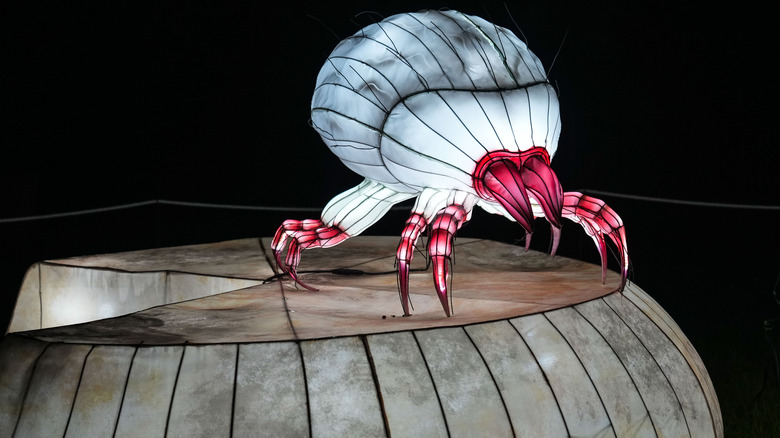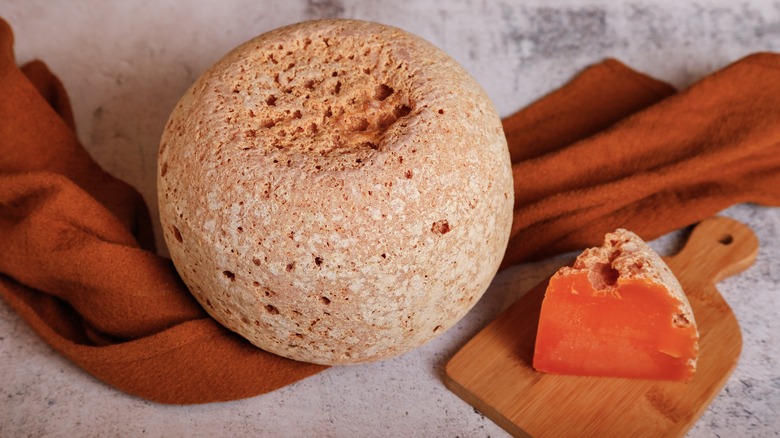Cheese Mites: The Beneficial Bugs That Make Boule De Lille Possible
The funkiness that sets stinky cheeses apart comes courtesy of microscopic organisms that digest the food, giving rise to deep and complex flavor over time. Bacteria and fungi can play a role in cheese fermentation and the ripening that's often associated with strong smells. But a particular kind of French cheese relies on an almost invisible arachnid to supercharge the process — the often-overlooked cheese mite. That cheese is Boule de Lille, also commonly referred to as Mimolette.
These little bugs exist on the outside of many different cheeses, and they're right on the edge of being too small to spot with the naked eye. Although they're technically arachnids, they're nowhere near as complex creatures as their cousins, spiders and scorpions. They live for about two weeks and don't even actually eat the cheese itself, they eat fungal hyphae that form on the surface of the cheese. But by burrowing around the place they create more surface area for bacteria and fungi, further altering the taste and texture of the cheese. Unique flavor compounds the mites themselves produce which have a profound impact on Boule de Lille as it matures.
How to tell if a cheese has cheese mites
Different kinds of mites reside in cheese. Among them are the flour mite (Acarus siro.) and the more formally recognized cheese mite species, Tyrophagus casei. Aged cheeses with natural rind are likely to have them. The mites thrive in the dark, cool environments where the cheese gets stored, but in the case of Boule de Lille (Mimolette), they are actively added to the cheese to get to work. Once the cheese is ready, the mites are brushed off or blown away with compressed air, they aren't shipped to the shops.
Because mites are minuscule, it is easier to look for their dust, which is a buildup of living and dead cheese mites and their debris. You'll see it on the cheese rind. In the case of very mitey cheeses like Boule de Lille, the surface itself can become cratered like the moon, but even some mature cheddars develop a powdery surface — it's not mold, it's mite dust.
The other telltale sign is a satisfying nutty tang. It can be compared to Parmesan after a few months, but the older versions are prized for taking on an almost maple-bacon, butterscotch nuttiness that's the perfect counterpoint to the cheesy tang of a mature fromage. Mimolette can be subbed in for cheddar in almost any recipe but is complex and satisfying enough to enjoy on its own or as part of a mighty mitey cheeseboard.
Boule de Lille: A cheese wedged between two countries
Thanks to the cheese mites, the older a Boule de Lille gets, the more pock-marked its surface becomes. This distinguishes it from Dutch Mimolette, which is covered in wax that specifically protects the cheese from the aging the mite accelerates. No matter how mature it gets, because of this seal, the Dutch version can only ever be an orange-hued variation on a familiar favorite — Edam. This cheesy divide is a source of pride for the few farmers and cheesemakers of Flanders who are keeping the old tradition alive. The story they tell of how their region came to be the home of French, cheese-mitey Mimolette goes back centuries.
In August 1667, Louis XIV, France's Sun King, captured Lille, the capital of Flanders, which had been part of what was known as the Spanish Netherlands. Later, France and the Netherlands would go to war over the territory, and Louis's Minister of Finance, Jean-Baptiste Colbert, started a complete block on all trade. At the time, by law, all French cheese was white, and all Dutch cheese was orange. Unfortunately, for the French, many of them enjoyed the Dutch cheese. Legend has it that rather than break the blockade, Colbert chose to ignore the color rule. He instructed the cheesemakers of Lille to create their own French version of the orange cheese using dye. While some experts dispute the details, cheesemakers and their mites have been making that French version for hundreds of years.


